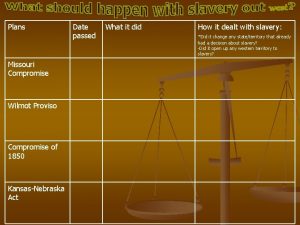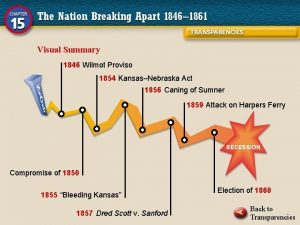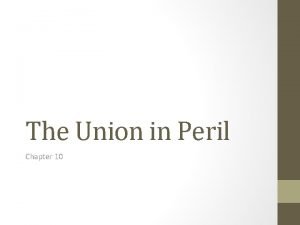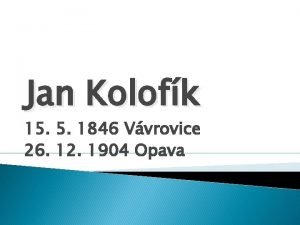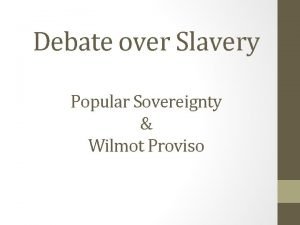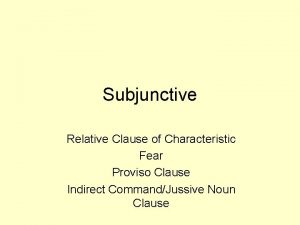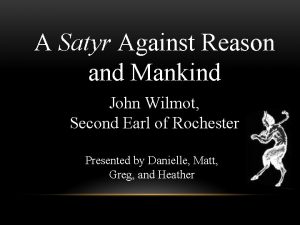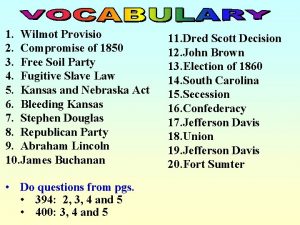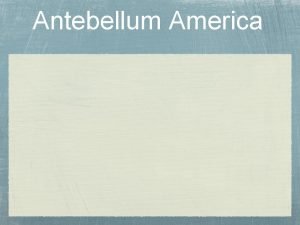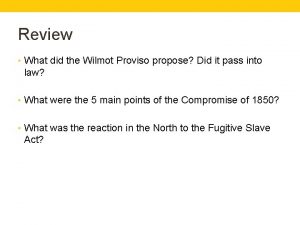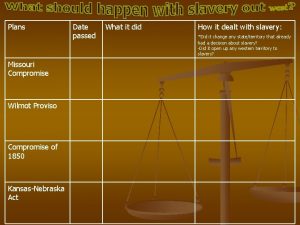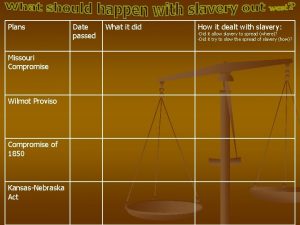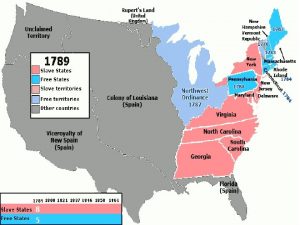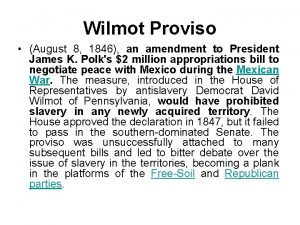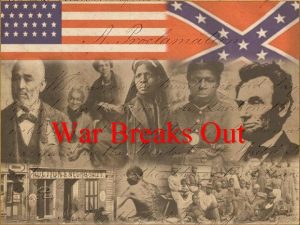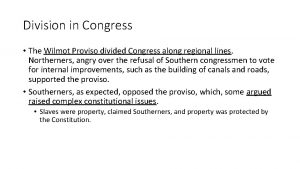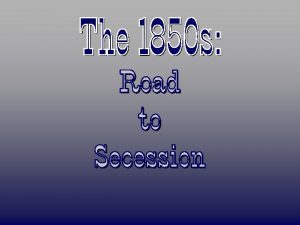Review What did the Wilmot Proviso propose Did

















- Slides: 17

Review • What did the Wilmot Proviso propose? Did it pass into law? • Banning slavery in all new territories – it was rejected and did not become law. • What were the 5 main points of the Compromise of 1850? • CA = free state • Texas gets $10 million to leave NM alone • Fugitive Slave Act • No sale of slaves in DC • Slavery in UT and NM decided by popular sovereignty (vote) • What was the reaction in the North to the Fugitive Slave Act? • Increased abolitionist activities and the growth of the Underground Railroad, and personal liberty laws in northern states

THE CIVIL WAR American History I - Unit 8 Ms. Brown

8. 2 – VIOLENCE ERUPTS IN KANSAS & NEBRASKA

Election of 1852 • Franklin Pierce • Democrat, states’ rights • Split on slavery • Winfield Scott • Whig, antislavery • Weak Whig party – Clay and Webster died in 1852 and the party was deeply split on slavery • Pierce = 14 th POTUS! • Whig party fell apart, eventually replaced by the Republican party

Douglas’s Proposal • Senator Stephen Douglas (Democrat - Illinois) helped pass the Compromise of 1850 but had other things in mind… • Pushed for the division of the large territory west of Iowa and Missouri create Kansas and Nebraska territories

Douglas’s Proposal • Why did Douglas want to create the Kansas and Nebraska territories? • Douglas wanted the construction of a railroad from Chicago, IL to San Francisco, CA would make Chicago wealthy • BUT Southern states wanted a similar railroad to start in a Southern city and would oppose his plan for a northern railroad through free territories • Douglas = Democrat, wants to be POTUS one day needs to please Southern Democrats

Douglas’s Proposal • Douglas proposed that the territory be broken into Nebraska and Kansas. • Both territories were technically supposed to be free due to being above the Missouri Compromise line • Douglas would lose support from Southern states and Democrats if these territories were automatically free. Nebraska Kansas

Douglas’s Proposal • Douglas proposed that slavery be decided in Kansas and Nebraska by popular sovereignty. Nebraska • Kansas – most likely slave territory, due to neighboring states • Nebraska – most likely free territory, bad soil for farming and plantations Kansas

Kansas-Nebraska Act • 1854 –Kansas-Nebraska Act • Divided the area in the mid-west into Kansas and Nebraska territories • Repealed the Missouri Compromise of 1820 by opening northern territories up to slavery

Aftermath of the Kansas-Nebraska Act • North = unhappy about the possibility of slavery in new territories • Criticized Douglas as a traitor and betrayer (he was from the North) • South = happy about the possibility of slavery in new territories • Praised Douglas as a true Democrat (promoted states’ rights) • The fate of the new territories and slavery was up to voters!

Aftermath of Kansas-Nebraska Act • Kansas up for grabs! pro and anti-slavery settlers poured into Kansas hoping to influence the vote on slavery • 1855 – Kansas had enough settlers to hold an election on slavery. • “Border ruffians” from slave state Missouri came into Kansas and voted illegally tipped the vote in favor of slavery

Bleeding Kansas • Pro-slavery groups set up Kansas’ capital in Lecompton. • Anti-slavery groups responded by established their capital in Topeka. • Established an anti-slavery town in Lawrence • High tensions and violence in Kansas in 1854 -56 gave Kansas the nickname “Bleeding Kansas. ”

Bleeding Kansas • 1856 – Sack of Lawrence • 800 proslavery men attacked anti-slavery Lawrence • Burned down headquarters, printing presses • Looted store and businesses

Bleeding Kansas • 1856 – The Pottawatomie Massacre • John Brown – believed God had called upon him to fight slavery • Brown mistakenly believed 5 abolitionists were killed in Lawrence • Brown and several supporters killed 5 men from the proslavery settlement Pottawatomie Creek • Hacked off hands and stabbed to death • Triggered revenge attacks in which over 200 people died.

Senate Caning • Violence spread to Congress in DC. • MA Senator Charles Sumner verbally attacked aged SC Senator Andrew Butler for supporting slavery and made rude comments about his impaired speech. • Butler’s nephew, SC Rep. Preston Brooks walked into the Senate chamber and said to Sumner… “I have read your speech twice over, carefully. It is a libel (false report) on South Carolina and Mr. Butler, who is a relative on mine. ”

Senate Caning • Brooks pulled out a cane and beat Sumner over the head repeatedly Sumner suffered from shock and brain damage, did not return to Senate for 3 years. • Reflected the growing tensions between the North and South…

 Wilmot proviso date
Wilmot proviso date Wilmot proviso summary
Wilmot proviso summary Why were threats of secession feared
Why were threats of secession feared Wilmot proviso apush
Wilmot proviso apush Wilmot proviso summary
Wilmot proviso summary The romance of a busy broker analysis
The romance of a busy broker analysis What did democritus propose
What did democritus propose Why did president wilson propose his fourteen points
Why did president wilson propose his fourteen points Result clauses latin
Result clauses latin Proviso in a sentence
Proviso in a sentence Soliti sunt ei credere
Soliti sunt ei credere Satire against reason and mankind
Satire against reason and mankind Wilmot provisio
Wilmot provisio Ivan wilmot
Ivan wilmot Eli whitney
Eli whitney Feel like gerund or infinitive
Feel like gerund or infinitive Man proposes but god disposes
Man proposes but god disposes Hát kết hợp bộ gõ cơ thể
Hát kết hợp bộ gõ cơ thể
